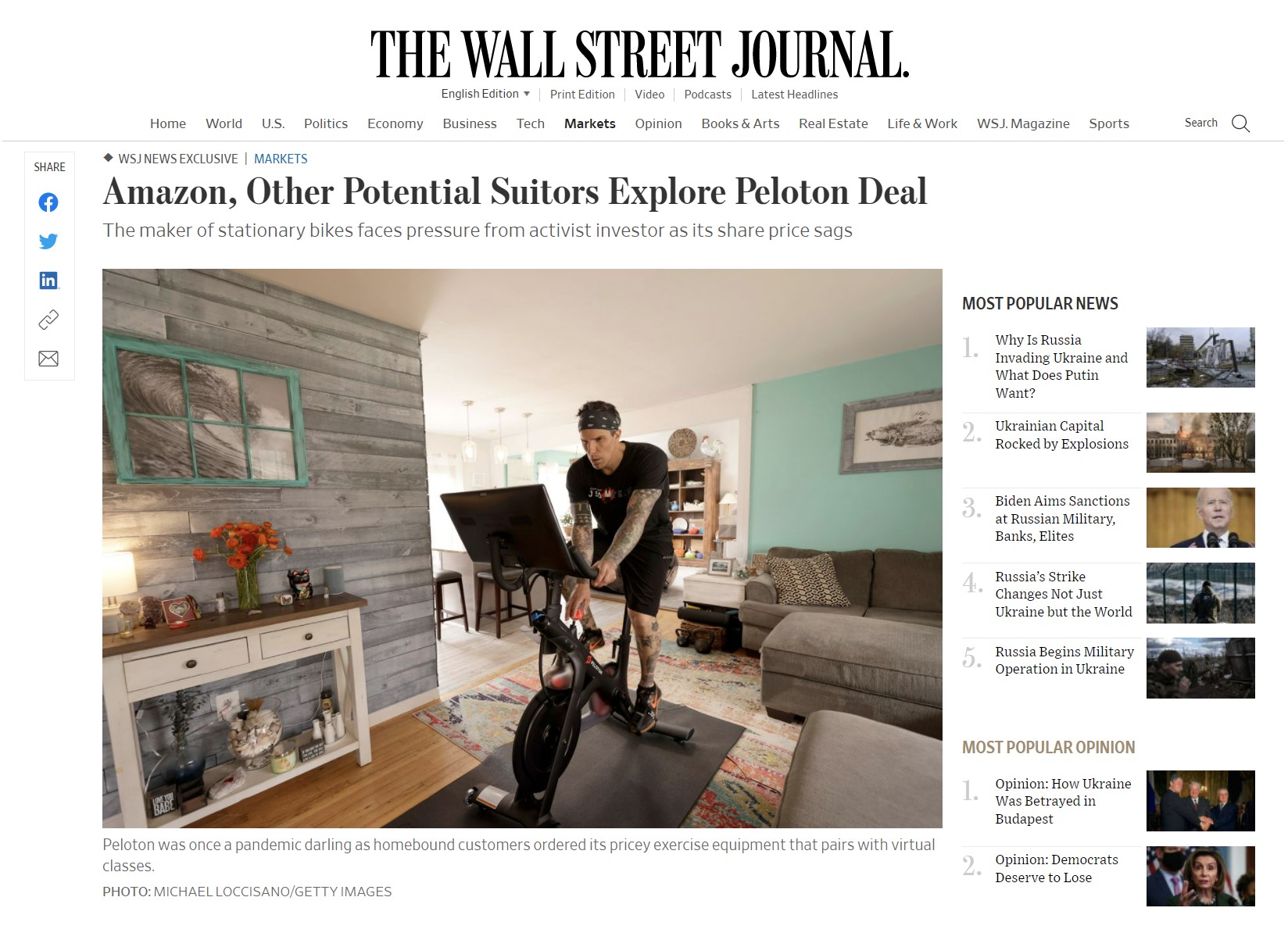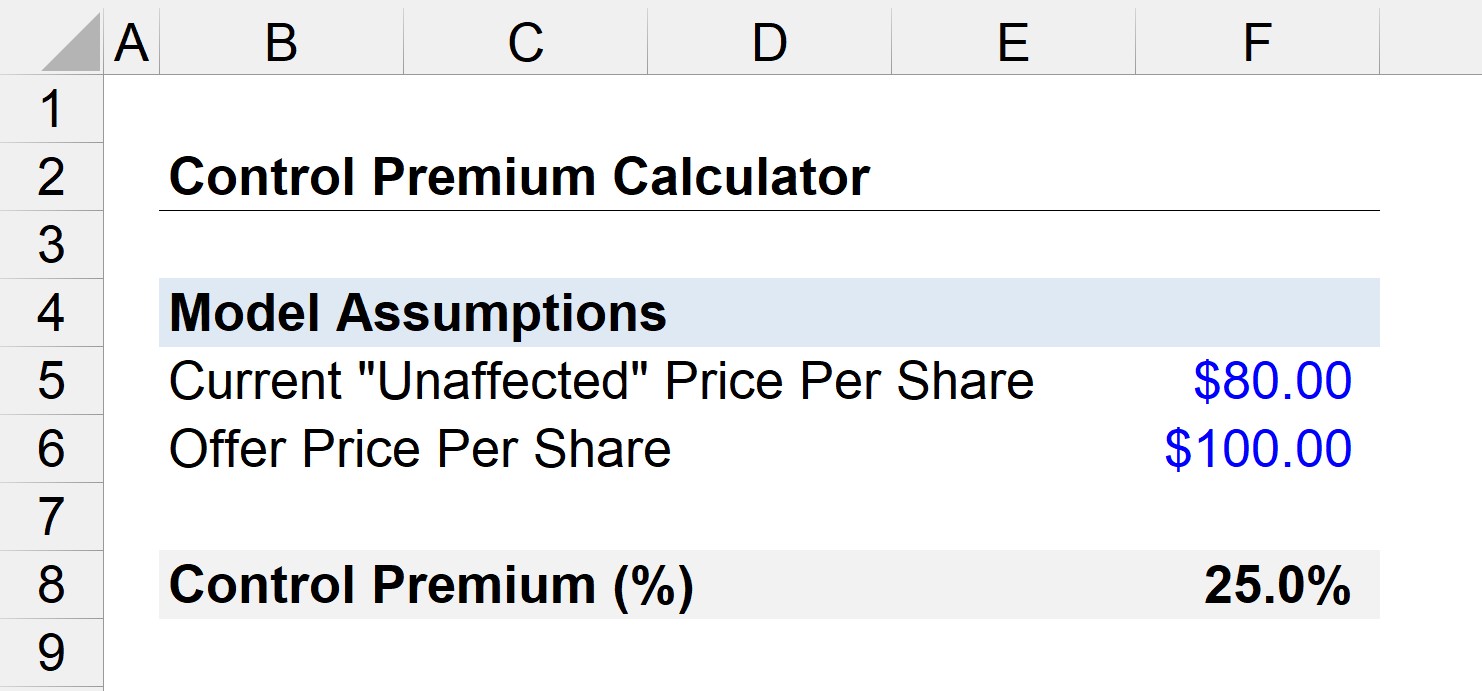- What is Control Premium?
- How to Analyze the Control Premium in M&A?
- What Causes the Control Premium in M&A?
- Strategic Buyers vs. Financial Buyers: What is the Difference?
- Control Premium Formula
- M&A Target Speculation Example: Peloton (PTON)
- How to Perform Premiums Paid Analysis in M&A?
- How is Goodwill Created in M&A?
- Control Premium Calculator
- Control Premium Calculation Example
What is Control Premium?
The Control Premium is the differential between the offer price per share and the unaffected market share price of the acquisition target, prior to speculative rumors of a potential M&A transaction and the official announcement.

How to Analyze the Control Premium in M&A?
In the context of mergers and acquisitions (M&A), the control premium is an approximation of the “excess” paid over an acquisition target’s share price by the buyer.
Control premiums are necessary for acquisitions such as leveraged buyouts (LBOs) to close, as existing shareholders require a monetary incentive to sell their shares, i.e. their ownership in the target company.
In the absence of a sufficient control premium, it is unlikely for an acquirer to successfully obtain a majority stake in the target.
Therefore, a reasonable premium is paid over the current share price in practically all acquisitions.
The control premium normally ranges from around 25% to 30%, but it can vary substantially from deal-to-deal and be as high as 50% above the target’s share price.
From the viewpoint of the pre-deal shareholders, there must be a compelling reason for them to give up their ownership — i.e. for the offer to be convincing enough, selling their shares must be profitable.
Since precedent transaction analysis (or “transaction comps”) values companies using acquisition prices for comparable companies, which factors in the control premium, the implied valuation is most often the highest relative to that derived from a discounted cash flow (DCF) or trading comps.
Learn More → Investment Banking Guide
What Causes the Control Premium in M&A?
There are numerous transaction-related factors that influence the size of control premiums, but the most common sources tend to increase the likelihood of a higher control premium include the following:
- Revenue or Cost Synergies
- Competition Among Buyers
- Inflated Valuation Environment
- “Cheap” Financing Available
- Hostile Takeover
- Shareholders’ Reluctance to Pay
- Strategic Acquirer
The control premium can also appear higher for companies whose stock prices have been underperforming, i.e. opportunistic purchase by the buyer in terms of pricing.
Thus, the yearly average share price performance must also be examined to understand the details regarding the transaction, not just the trading price, a few days before rumors or news articles began to circulate.
However, the transaction considerations surrounding each acquisition are unique, e.g. a certain premium could be reasonable to a buyer that anticipates significant synergies, whereas the same premium can be irrational and considered overpaying to another buyer.
Strategic Buyers vs. Financial Buyers: What is the Difference?
The buyer profile is a notable factor that influences the size of the control premium, i.e. if the acquirer is a strategic acquirer or financial buyer.
- Strategic Buyer → Generally, premiums are higher in deals involving a strategic acquirer (i.e. a company acquiring another company), rather than deals where the acquirer is a financial buyer (e.g. a private equity firm). The reason is that strategic acquirers can usually benefit from more synergies, which directly raises the maximum amount it is willing to pay for the target.
- Financial Buyer → Conversely, financial buyers cannot benefit from synergies — and overpaying is a frequent mistake that results in disappointing investment returns (e.g. internal rate of return, money-on-money multiple). However, add-on acquisitions are an exception, as PE-backed portfolio companies are typically then acquiring smaller companies and can afford to pay more since synergies can be realized.
Control Premium Formula
The control premium formula consists of the two inputs.
- Offer Price Per Share: The acquirer’s offer to purchase the target on a per-share basis.
- Current “Normalized” Price Per Share: The share price of the target before news of the acquisition leaked, which causes upward or downward share price movement based on how the market perceives the deal.
The control premium equals the offer price per share divided by the current price per share, minus one.
The control premium is expressed in percentage form, so the resulting figure must be multiplied by 100.
Ensuring the current share price is “normalized” and depicts the pre-deal market price is crucial. Otherwise, the current share price includes the (positive or negative) impact of rumors that could have leaked to the public prior to the official announcement of the acquisition.
M&A Target Speculation Example: Peloton (PTON)
As an illustrative example of how rumors can impact share price, Peloton (NASDAQ: PTON), a seller of exercise bikes and remote classes, saw its share price appreciate substantially due to the pandemic and work-from-home (WFH) trends.
But in early 2022, Peloton reported a disappointing Q2-22 earnings report (and slashed its full-year outlook due to lack of demand and supply chain issues).
The market capitalization of Peloton fell by around $8 billion — which is quite a steep drop-off from a market cap that peaked near $50 billion.
An article by the Wall Street Journal (WSJ) fueled rumors about a potential takeover, with a list of suitors that included Amazon, Nike, Apple, and Disney.
Soon after, Peloton’s shares surged more than 20% in a single day after a weekend of non-stop speculation spread by journalists and news coverage.
Despite the reports of interest being preliminary and there being no proof that Peloton had officially hired a sell-side advisor to consider a sale, its share price was nevertheless elevated due to speculation among investors.

“Amazon, Other Potential Suitors Explore Peloton Deal” (Source: WSJ)
How to Perform Premiums Paid Analysis in M&A?
Premiums paid analysis is a type of valuation where an investment bank compiles data on comparable transactions and the estimated premiums paid for each.
By taking the average of the historical premiums, an implied range can be used to guide negotiations of an acquisition on behalf of their client, either on the buy-side or sell-side.
- Seller’s Perspective: Since the past premiums paid on comparable deals were evaluated, the seller can rest assured their sale price was maximized.
- Buyer’s Perspective: On the other side, the buyer can confirm their offer value was near what others paid, i.e. as a “sanity check” that they did not needlessly overpay.
How is Goodwill Created in M&A?
As part of purchase price allocation, if a premium is paid in an acquisition, the acquirer recognizes the difference between the offer price and fair value of the target’s assets as “goodwill” on its balance sheet.
Goodwill captures the excess purchase price over the fair value of the target’s assets — otherwise, the accounting equation would not remain true (i.e. assets would NOT be equal to liabilities + shareholders’ equity).
Periodically, the acquirer will evaluate their goodwill account to check for signs of impairment. If deemed so, there will be an appropriate reduction to the goodwill line item on the balance sheet in the current period, as well as a write-off expense recorded on the income statement.
Control Premium Calculator
We’ll now move to a modeling exercise, which you can access by filling out the form below.
Control Premium Calculation Example
Suppose a company’s shares are currently trading at $80 per share in the open markets.
Moreover, a private equity firm is pursuing an acquisition (LBO) of the company with an offer price of $100.
Amid negotiations, rumors around buyout interest are leaked, and the target’s share price rises to $95 per share.
So our question is, “What is the control premium if the deal ends up closing?”
First off, we know the unaffected share price is $80 prior to the news leaking.
- Offer Price Per Share (“Unaffected”) = $100.00
- Current Price Per Share = $80.00
The control premium in this case can be calculated using the following formula:
- Control Premium = ($100 / $80) – 1 = 0.25, or 25%
Therefore, in our simple scenario, the acquirer paid a 25% premium over the unaffected share price.

Everything You Need To Master Financial Modeling
Enroll in The Premium Package: Learn Financial Statement Modeling, DCF, M&A, LBO and Comps. The same training program used at top investment banks.
Enroll Today






